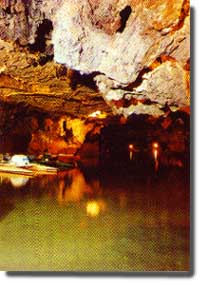Sarab Cave in Hamedan-Azerbaijan
Sarab Cave in Hamedan-Azerbaijan
Sarab Cave in Hamedan: A Source of Sweet Water with 6 km Length
Hamshahri (Morning Daily)
April 17, 2001, No. 2379
By: Mostafa Salahi
Page: 7
Word Count: 1169
Summary: Sarab Cave is located 6 kilometers away from Ali-Sadr Cave's mouth and, is at an elevation of 2,570 meters. Studies about volume of water from Sarab Cave which supplies the sweet water to Sarab village, has revealed lakes with 6,000 m length. The cave is made of metamorphosed slate clay rocks and limestone.
Text: Beside introducing a sightseeing site in Hamedan, the object of this report is to point to an abundant underground water source and discuss the method to preserve it and use its water in the best way possible.
Sarab Cave is located at a 6 km distance from Ali-Sadr Cave. Sarab, Ali-Sadr and Soobashi caves are located at Sari-Qieh Mountain Ranges in Hamedan with an elevation of 2,570 m.
THE WAY THE CAVE WAS NOMINATED
In western Iran wherever the inhabitants observe rainwater gushing out of interconnected lines through a spring, they call it sarab.
From 1961 onward Sarab and Ali Sadr caves were discovered and visited by mountain-climbers in Hamedan. However due to difficulties in the Sarab Cave such as separate lakes, separate, narrow and sloppy vestibules, and the need to carry a lot of provision and driving boats from one lake to another lake; in each inspection part of the cave is explored by a specific team. In the longest inspection carried out by mountain-climbers, about 800 m of Sarab Cave was explored without taking into account side vestibules, canals and dead ends.
I am in possession of the measurements of Sarab Cave including the length, width and depth of the lakes which have been supplied by mountain-climbers in Hamedan. A calculation of flow rate (i.e. the amount of water flowing out of the cave in a minute) made me to conclude that the length of the lakes and connecting vestibules must be around 6 km and it was necessary to explore another 5 thousand meters of lakes and canals in the cave.
As a consequence, I talked to several master mountain- climbers who had repeatedly inspected Sarab Cave, including Asghar Poorhusseini, Ostad Mohammad Banna and Abbas Ranjbaran, and together we proceeded to the cave.
We carried enough provision and equipment for 24 hours sojourn in the cave including lighting equipment, food, clothing and rubber boats. The inspection was carried out on Dec 6, 2000, and during the tour we assembled three boats. Each boat cruised one of the big lakes in order to save time because the boat ballasting and deballasting takes a long time.
The inspection took 20 hours and we visited all the routes that had been previously identified by mountain-climbers along with several new vestibules of 100 to 200 m length, but we returned earlier than we had planned without being able to discover a new lake or vestibule.
The first reason for our early return was that the mouth of the cave was cut to 3 m by 3 m in size. This enlargement has disturbed the natural structure of the mouth of the cave and causes permanent exchange of outside low-pressure air and inside high pressure. The constant cold wind from outside to inside the cave helps tens of cubic meters of water to evaporate and escape the cave every day.
During our visit the temperature fluctuated between 2-4 degrees Celsius, and the freeze made things difficult for us. The mountain-climbers who knew the condition of the cave should have shut the mouth of the cave with a plastic curtain to create necessary calm required for smooth cruising, but they failed to hang the curtain. A second reason for early return was that the team had carried 20 air capsules which was not enough for breathing and upon our return we had only two capsules to use. Thirdly, the water level had sunk by 160 cm which had created unexpected difficulties for the team.
CAVE STRUCTURE
Sarab Cave is made of a combination of metamorphosed slate clay rocks and limestone. The limestone has been eaten up by acid rains fallen since a million year ago and the process has created the present giant cave. As a result of this acid invasion the nonsolvable slate clay has survived intact and has formed the present ceilings, walls and the columns in the cave.
In the course of hundred thousands years the water elevation in the cave has remained unchanged and the stone- manufacturing process has led to projected sharp lime edges around the lake. In some vestibules the lime edges have joined each other and have formed a ceiling over the lake. Throughout the cave one can see beautiful natural water sprinklers.
Sarab Cave possesses a large basin with many holes and indentures at the sides that help it to absorb surface rainwater and add to its water reserve. The water thus collected join together and issue out of the cave in the form of a spring at an elevation of 2,200 m from sea level and is used for irrigation of farms in Sarab village.
During recent years the villagers have dug a cavity 2 meters below the nature cave mouth to drain more water for irrigation. This lowering of the water canal and shortage of rainfall in recent years has caused the elevation of the lakes to sink by 160 cm according to recent measurements. The decline of water level leads to two destructive interactions:
1. With the decline of water level the pressure of lake over the side wall decreases and the cave starts to crumble;
2. Once the slate clay walls exit from the water they grew compacted and start to slide. The sliding causes repeated crash of side walls and the debris is filled in the lakes. With the fall of the debris the height of the water declines and the cave looses its natural capacity to attract more water. Right now one vestibule with about 200 m length is falling and is dangerous for visitors.
SOLUTION
By building a 20 m circular concrete wall in front of the present cave exits, the water will cease from flowing out and its elevation of lakes will rise. Now one can profit from the energy resulting from fall of water from the high- elevated cave and lower farms.
Also by laying a drainage pipe, one can lead the water from the first lake outside in a systematic and controlled manner. The mouth of the exit pipe must be narrow and be equipped with a valve so that it can be closed when there is no need for irrigation water. This can help us to stop wasting the precious water.
The same system can be employed in all the caves in Iran including the giant `Taq-e Bostan Cave'. Iran is an arid region in the world and its rainfall is quite irregular and scarce and we must preserve every drop of water to escape draught.



























0 Comments:
Post a Comment
<< Home